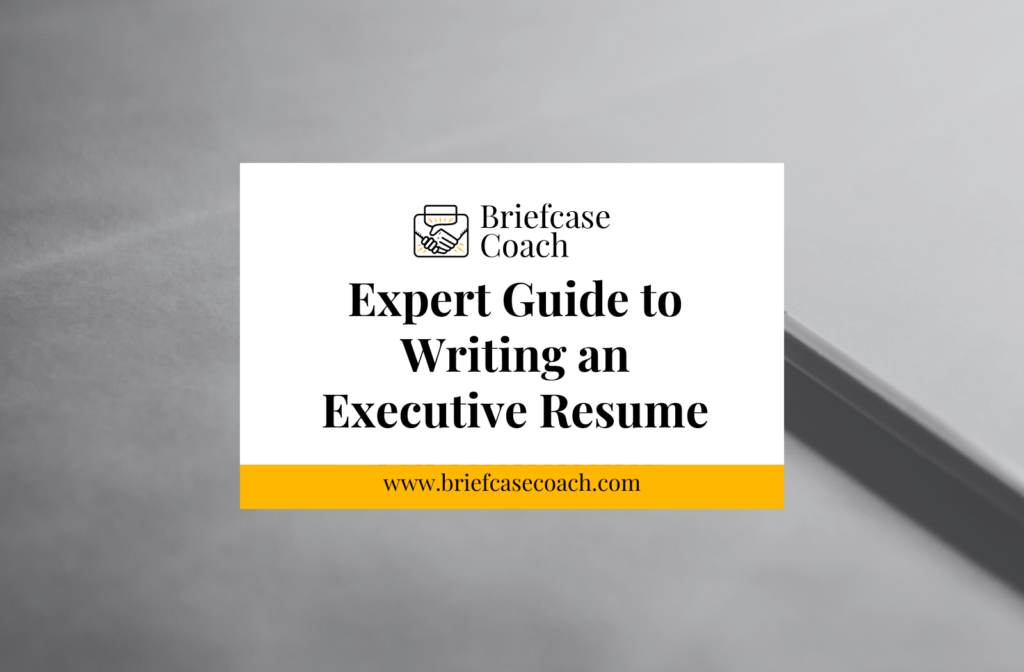
Writing an Executive Resume with Examples and Worksheets
Everyone has a story to tell. Writing an executive resume is an opportunity to unlock your own story and grow in your ability to share it with others. In this article, I will help you tell your story better in the form of an executive resume.
To create a captivating resume, it is essential to engage in introspection regarding your own qualities, strengths, and distinctive value proposition. Doing so will equip you with an outstanding resume and the ability to effectively communicate your unique value proposition to others.
The Goal of a Modern Executive Resume
The goal when writing a resume is to leave no doubt in the hiring manager’s mind that you are qualified and capable of doing the job. Not only do you have to tailor the content to the exact role that you’re interested in, but you also need to sprinkle your resume with exact keywords and phrases from job descriptions of interest.
While keywords certainly hold significance, it’s crucial that a resume DIFFERENTIATES the job seeker from other applicants. A great resume facilitates a connection between the candidate’s unique value proposition and the organization’s specific needs, aiding the reader, whether a recruiter or hiring manager, in understanding this alignment
Don’t Make the Common “Kitchen Sink” Resume Mistake
A prevalent error among executives is sticking to the outdated one-page resume format they crafted in business school. Rather than revising and tailoring it for their target position, they simply pile on more recent experiences at the top while pushing older roles further down the page.
The problem with this strategy is that it creates a “kitchen sink” resume. It’s not targeted, there’s no storytelling element, and it’s just a bland list of jobs and tasks completed.
A modern executive resume is a marketing document. It starts the conversation about how exceptional you are as a candidate, with compelling results demonstrating your value. A powerful resume should be tailored for the job you want, not your current job.
“Kitchen Sink” Resume Example:
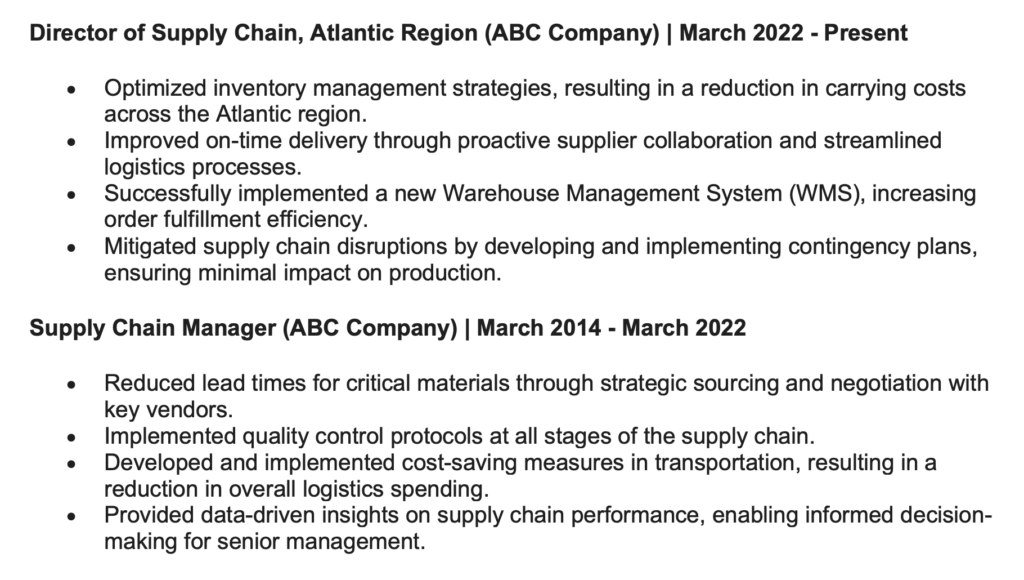
This example neatly displays job titles, dates of experience, and four bullet points of tactical results. However, the document is selling the story short. Most executives can come up with impressive bottom-line results. However, a thoughtful and transformational leader who has experience driving the business forward has a unique branding piece that, when added, will set the resume apart.
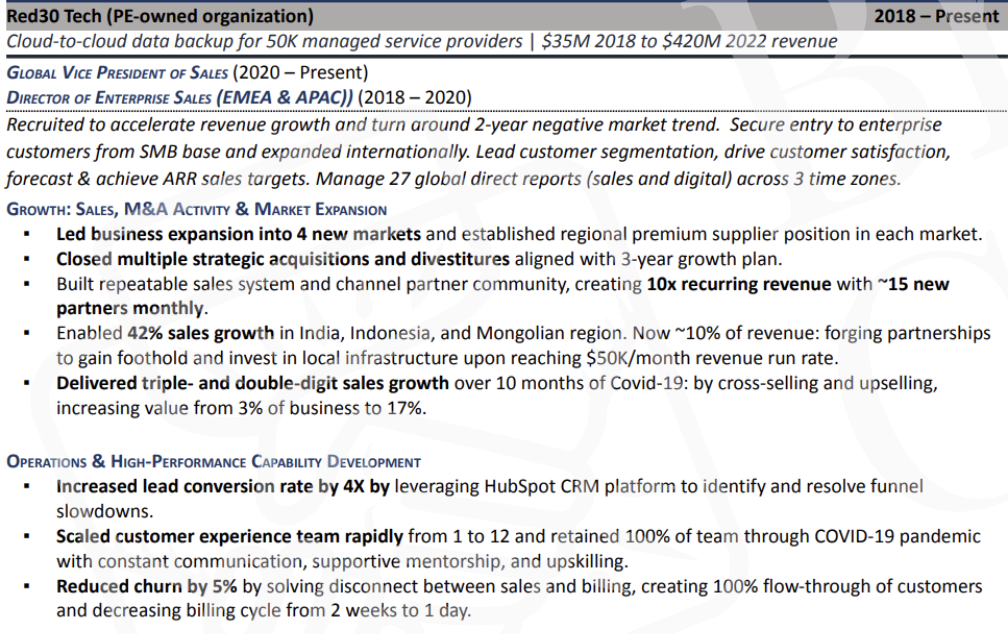
It is important to showcase this competitive advantage, adding employee engagement results, leadership philosophy, and a few impressive wins. Modern companies are looking for well-rounded leaders. A modern resume should include your technical skills, high-quality results, and who you are holistically.
Lastly, and most importantly, your resume needs to tell the reader your unique value proposition. Or, more simply put, what’s your secret sauce? The recruiter or the hiring manager needs to be able to quickly assess your strategic positioning and how you can meet the organization’s pain points.
Read more: How far back should your resume go?
You as a Leader
When it comes to hiring, you are the brand. Selection committees meet to discuss qualities and characteristics, or brand features that they want to see in a final candidate. Your career collateral needs to express what sets you apart from your competition.
For senior leaders, managers and executives, at your career level, you have had quite a few jobs. What are you known for in these jobs? What are common themes across your tenure in each of these positions? Your resume will stand out in the stack if you can clearly articulate your unique value proposition.
Common Value Propositions of Executive Leaders
Some common personal value proposition themes that I see with executives include innovation, execution, creativity, efficiency creator, collaborator, transformational and culture changer.
To assist you in answering the question, “What are you known for?” I have prepared a worksheet for you. This worksheet will aid you in uncovering your unique value proposition, allowing you to communicate your story effectively. By going through these questions, you will begin to develop a clearer understanding of your unique value proposition. Once you have a solid grasp of your own strengths and qualities, you will be able to tell more focused and impactful stories.
Importance of a Focused Job Search
The goal of an executive resume is not to craft a “kitchen sink” document but instead quickly summarize why you are the ideal candidate for this job, not a job.
If your job search lacks focus, you are not yet prepared to create a modern executive resume. Before you begin writing your resume, it is crucial to clearly define your ideal job title and compile a shortlist of five to six preferred companies. Without this intentional approach, your value proposition will be weaker and may not resonate with hiring managers and recruiters.
Be the Hiring Manager
Imagine yourself in the shoes of the hiring manager. If they receive 50 applications for a position and they only plan to interview three or four candidates, don’t you think they would choose the candidate whose resume is most closely aligned with the role? It’s Marketing 101 to know your target audience and understand what they value. When you have a clear idea of your ideal next role and a well-thought-out list of target companies, it becomes easier to create a resume that speaks the language of your target audience. Let’s be honest here – a high-growth, 50-person startup will prioritize different things compared to a highly-matrixed Fortune 500 organization. Psychology teaches us that mirroring both verbal and nonverbal communication helps build trust in relationships.
Use the Job Description as Your Roadmap
A team of behavioral scientists led by NSAID professor Dr. William Maddox tested the effectiveness of mirroring in business situations, and found it significantly increases positive influence. So much so that in the experiment, mirroring enhanced the closing rate of salespeople in a study by 17%. The same is true in written communication. When you subtly mirror language in a resume, you’re optimizing the word choice for a specific reader.
Studying the job description is an easy way to identify the keywords and phrases that are important to the company, industry, and position you’re applying for. By incorporating excerpts and keywords from the job description or the company website into your document, you’re essentially providing the reader with exactly what they’re seeking. This is particularly significant in today’s competitive job market. Recruiters have short attention spans, typically spending only about six to 13 seconds reviewing a resume. However, if they come across something that captures their attention, such as familiar language, they’re more likely to invest additional time in reviewing your documents.
Use Keywords
Most companies use ATS, or Applicant Tracking Systems, a computer software program that manages the hiring process. Depending on how a specific ATS works, the location and frequency of keywords within your resume can be extremely important. While some TikTok career coaches may advise you might tell you to use the “white font resume trick,” we do not recommend it! The goal of a resume is not to get a 100% keyword match. Instead, you want to select essential keywords from the job description text and place them strategically to avoid keyword stuffing. Some applicant tracking systems, like Zoho, reward keywords with context.
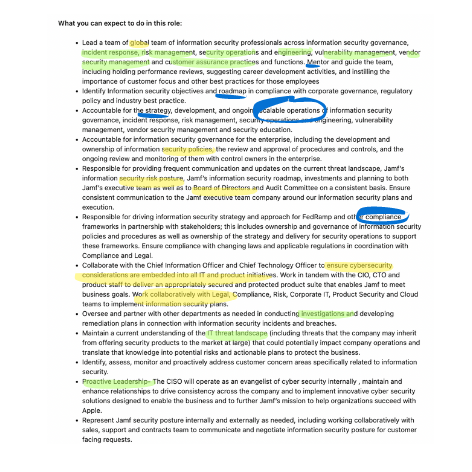
When you are looking for keywords, focus on recognizing technical skills and industry jargon that are often essential for certain job roles. Pay attention to mentions of specific technologies, tools, software, or industry-specific terms such as “C++,” “Azure,” or “Six Sigma.” These terms provide insight into the technical expertise required for the position.
Afterward, pinpoint the soft skills mentioned in the job descriptions. These descriptors typically pertain to interpersonal or organizational abilities vital for success in different roles. Seek out terms such as “team player,” “adaptability,” “excellent communication,” or “conflict resolution,” as they reflect the candidate’s capability for collaboration, leadership, clear communication, and problem-solving. Recognizing both technical expertise and soft skills is crucial for developing a thorough and persuasive resume that aligns with the job specifications.
ChatGPT can serve as a highly useful tool for identifying resume keywords. Simply copy and paste the job description into ChatGPT. Then, gently prompt the model to recognize the essential keywords by asking, “Please identify the essential keywords in this job description.”
Remember: use the exact same wording that is used in the job description for the keywords in your resume.
Writing an Executive Resume
The Resume Header
Utilizing the header at the top of your resume is an excellent opportunity to incorporate the job title or highlight key pain points mentioned in the job description. Think of the header on a resume as similar to a newspaper header – it provides the reader with a glimpse of your identity and the value you can offer to an organization. Take advantage of the header section to include relevant keywords, themes from the job description, or showcase your unique value proposition.
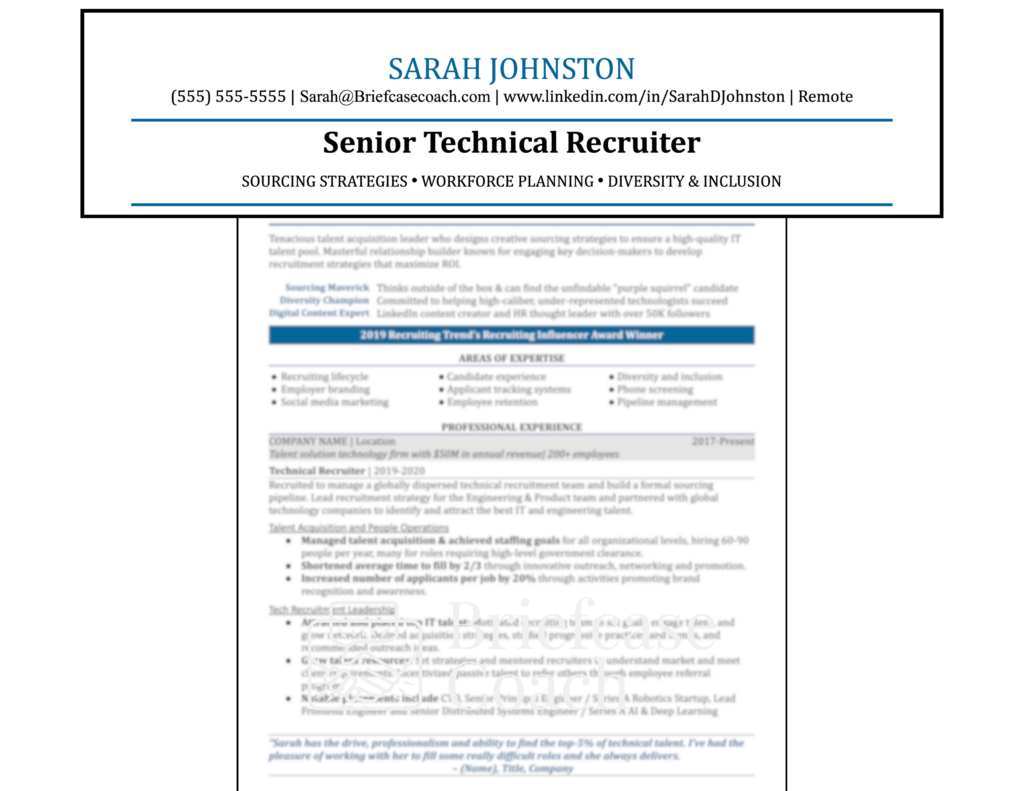
The Executive Resume Summary
Below the header, you’ll find an executive summary. This section is an excellent opportunity to use language that mirrors the job description. Remember, recruiters and hiring managers typically spend only six to eight seconds scanning your resume initially. By clearly demonstrating how well you align with the role, you increase the chances of them continuing to read your resume.
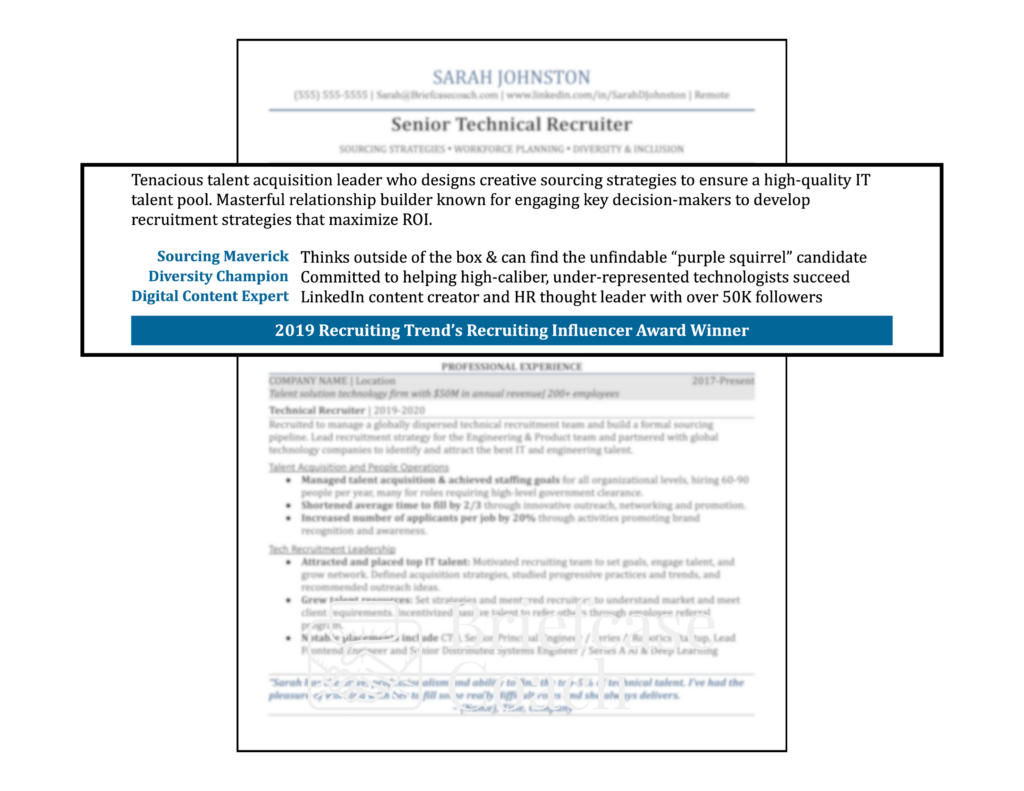
Area of Expertise Section
You can also include an area of expertise section, just as this sample includes. This section is a great place to include exact keywords and phrases from the job description. Beyond using job descriptions to identify keywords, you can also use the job description as your guide for identifying relevant experience to showcase. So let the keywords help you seize the opportunity to present the best version of you.
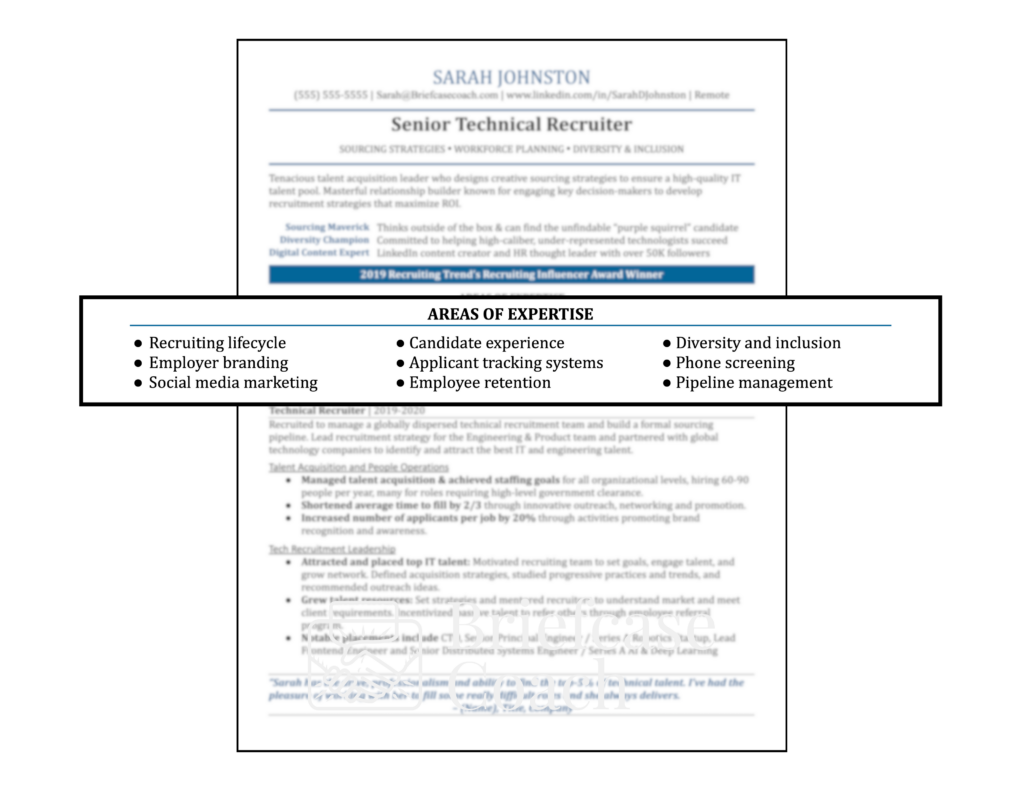
Work Experience Section
Make your story really stand out in the work experience section of your resume. Knowing what your target audience cares about makes it easier to curate career highlights that will resonate with hiring managers. Design resume bullet points, using the job description as a guide.
A job description outlines the ideal candidate: they want someone who can Identify and engage unique and/or passive candidates through creative sourcing. Ask yourself, what are examples of unique ways that you’ve engaged candidates? and how have you identified passive candidates through creative sourcing strategies?
Did one of your answers give you a unique story, a creative, out-of-the box what you identifies and sourced candidate? Use that story for a resume bullet. The bullet point may read:
- Increased software engineering applications by 20% through out-of-the-box sourcing initiatives for hard-to-fill positions, including hosting the company’s first Slack community coffee hour and filling mission-critical positions.
Take the time to carefully review each line of the targeted job descriptions. Look for stories and results that you can potentially incorporate into your resume content, ensuring alignment. While this may seem like a tedious task, it will greatly assist you in recalling specific situations during future interviews. The extra effort you put in will truly set you apart from other candidates and enable you to present yourself more confidently, both on paper and in person.
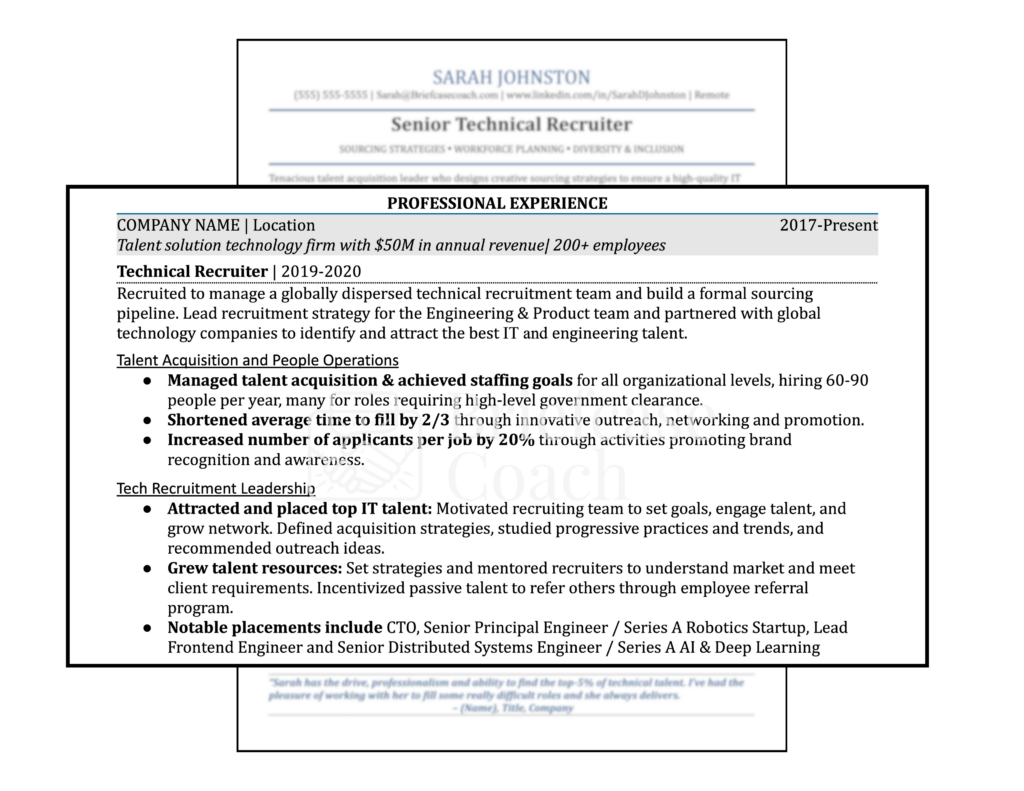
Identify Key Performance Indicators
When you’re writing your resume, it’s important to remember that the hiring manager needs to know, what’s in it for me if I hire you? It’s one thing to say that you’re good at your job. It’s another thing to demonstrate that you can accomplish your goals and exceed expectations.
Brainstorm before Writing an Executive Resume
One of the best ways to brainstorm results is to start by identifying any outcomes that could be considered key performance indicators. For example, if you’re a sales leader, your KPIs might include the number of new contracts signed per period, or annual sales growth, or dollar value for new contracts signed per period, or average time for conversion. If you’re having a hard time remembering these numbers, go through old performance evaluations or ask a former colleague.
Metrics and data help hiring managers understand the impact that you’ve made. A resume should be accomplishment-driven, and not responsibility-focused. When you’re listing your results on your resume, you’ll want to use numbers and percentages, rather than words, to streamline your phrasing and to stand out visually.
Example questions to ask yourself to identify result-rich accomplishments:
- In your current role, how does your hiring manager, leader, or board measure your success?
- Did you bring on any new technology? If so, how successful was the implementation?
- Have you been involved in and/or led any productivity or efficiency improvement projects?
- Did you suggest any ways to cut costs on your team or in your organization? How much did you save your company?
RAS Formula for Result Rich Bullet Points
Many career centers and resume writers teach the C.A.R. method as an effective strategy for writing an executive resume.
While C.A.R (Challenge > Action > Result) is an effective approach, I have an e͟v͟e͟n͟ ͟b͟e͟t͟t͟e͟r͟ formula for writing result-rich bullet points.
I recommend flipping the C.A.R backward to present your story using the RAS (Result > Action > Situation) formula instead.
This ensures that you are LEADING with the result.
𝐇𝐞𝐫𝐞’𝐬 𝐚𝐧 𝐞𝐱𝐚𝐦𝐩𝐥𝐞:
Increased software engineering applications by 20% through out-of-the-box sourcing initiatives for hard-to-fill positions, including hosting the company’s first Slack community “Coffee Hour.”
⬆️
When you lead with the result, you aren’t burying the most important information.
𝗛𝗲𝗿𝗲 𝗮𝗿𝗲 𝗮 𝗳𝗲𝘄 𝗼𝘁𝗵𝗲𝗿 𝗲𝘅𝗮𝗺𝗽𝗹𝗲𝘀:
Reduced spend per user from $7K to $4K while increasing service level measures by scaling growth through M&A and right-sizing expenses.
Achieved 36% revenue acceleration: crafted, secured BOD approval and executed strategy to refine brand positioning to deepen consumer relationships and differentiate.
Increased average credit facility commitments by 65% via up-tiering of 9 key client relationships through consistent, strategic, and proactive relationship management.
A great executive resume is both powerful + succinct. Sometimes, it’s best to get the point across without using the entire RAS formula. I may write a bullet point that is just RA (Result + Action) or RS (Result + Situation).
H͟e͟r͟e͟ ͟i͟s͟ ͟a͟n͟ ͟e͟x͟a͟m͟p͟l͟e͟ ͟o͟f͟ ͟R͟e͟s͟u͟l͟t͟ ͟+͟ ͟A͟c͟t͟i͟o͟n͟
Decreased run rate by $50M/yr through process standardization, headcount reductions, and labor arbitrage.
B͟͟͟e͟͟͟l͟͟͟o͟͟͟w͟͟͟ ͟͟͟a͟͟͟r͟͟͟e͟͟͟ ͟͟͟t͟͟͟w͟͟͟o͟͟͟ ͟͟͟e͟͟͟x͟͟͟a͟͟͟m͟͟͟p͟͟͟l͟͟͟e͟͟͟s͟͟͟ ͟͟͟o͟͟͟f͟͟͟ ͟͟͟R͟͟͟e͟͟͟s͟͟͟u͟͟͟l͟͟͟t͟͟͟ ͟͟͟+͟͟͟ ͟͟͟S͟i͟t͟u͟a͟t͟i͟o͟n͟
Achieved 3% attrition rate in 2022 out of 600 reports, well below company average of 12%.
Secured 150%+ YOY revenue growth for assigned accounts.
Highlight Soft Skills When Writing Your Executive Resume
Many organizations believe it’s harder to cultivate emotional intelligence in leaders than it is to recruit leaders who already possess high EQ. The number one unspoken rule of a modern executive resume is show, don’t tell. It is important to ensure that the employer is able to derive the conclusion that you have a high emotional intelligence through what you’ve achieved – highlight your soft skills.
Leadership Philosophy
There are many different ways that you can showcase soft skills throughout your resume. A few of my favorite strategies are including a leadership or sales philosophy. A leadership philosophy allows you to succinctly articulate to others who you are and how you influence and lead.

Survey Results
Another way to effectively showcase your leadership EQ is by highlighting your employee engagement survey results. The term employee engagement relates to the level of an employee’s commitment and connection to an organization. Many engagement surveys measure a leader’s communication, goal setting, trust, and support. If applicable, include employee engagement score results as a bullet point within specific job experiences that the feedback relates to.
Testimonials
Testimonials are one of my favorite ways to highlight soft skills on an executive resume. Use this space to reinforce key themes like collaboration, delivering results, or building high performance teams. Consider lifting a quote for your testimonial from an old performance evaluation, a promotion announcement, or from your LinkedIn recommendation section.

Include DE&I Intiatives
Adding examples of ways that you have made the workplace more diverse and inclusive highlights your ability to help create a sense of belonging for others. Examples can include strategies and results you’ve led to attract a more diverse workforce, employee resource group, ERG involvement, and ways that you’ve championed employee wellness.
Examples of D&I on a resume include:
- Boosted diversity of leadership hires by 29% via revamped hiring requirements & interview guidelines.
- Coordinated study with ED physicians to study racial bias in ED setting and prioritize racial justice in ED care.
- Trained 75 facilitators to lead Courageous Conversations on racial inequities to build empathy, awareness, and understanding. Engaged 10K staff within 90 days.
- Championed employees’ mental, physical, and financial health by launching the “Belong Committee” to build programming to support employees. 85% of employees agreed that their managers care about them as a person and recognize their contributions to the company in 2023 survey.
Financial acumen and operational prowess will only take you so far in the interview process. Companies want leaders with strong social skills and emotional intelligence.
Use of Design Elements when Writing a Modern Executive Resume
Design elements such as bolding and shading can make the resume easier to read. You can use underlining and call out boxes to manipulate the reader’s eyes to look at the most critical details. Some best practices to follow when designing your resume include writing short paragraphs. An example, for the executive summary, three to four sentences or lines are ideal.
Embrace White Space
White space, or the space between sections or paragraphs on your resume gives your text breathing room. When a resume lacks white space, it can feel cluttered or hard to read. White space can help ensure important details don’t get missed or overlooked because the reader is overwhelmed.
Section Headers
Section headers can be an effective way to break up the text and make it easier for the reader to skim the document. As mentioned, most recruiters spend less than 10 seconds reviewing a resume and making an initial decision on the candidate. Section headers can help draw the readers attention to the points in your story you feel will be most important. Example headers include skills, experience, technical expertise, education, and community involvement.
Font and Color Choices
The format, typography, visual elements, and arrangement of a modern resume are significant. Our attention spans have become shorter compared to previous times. Additionally, it is important to note that a considerable percentage, ranging from 40 to 60%, of resumes are reviewed on an iPhone at some stage of the hiring process. Therefore, your design should be uncomplicated enough to make an impact on a six-inch display.
Here’s an example that demonstrates how font and visual elements can enhance a resume and make the information on it stand out. Both resumes convey the exact same content; the only distinction lies in the visual elements.
Which of the two do you find more visually appealing?
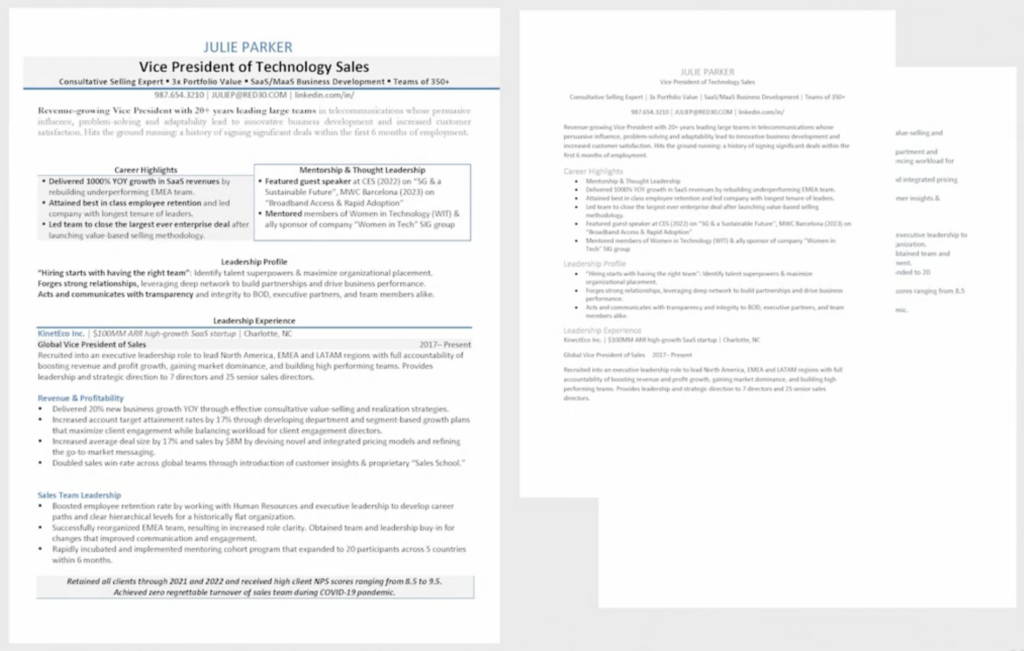
Pops of color (that are on brand) can also make your document more visually appealing and stand out. Use color conservatively and, I recommend sticking to blues, grays, or occasionally greens.
Regardless of which design elements you incorporate into your resume, or choose to leave out, be sure to keep in mind that this is YOUR narration of your unique value proposition. Your resume design should be a reflection of your personal brand and should differentiate you from your competitors.
Read more: What Should a VP of Operations Resume Look Like?
Resume Page Length
Resume page length is often hotly debated. We prescribe to the philosophy that a “resume can be as long as it needs to be and no longer.” It’s not uncommon for an executive resume to be two or three pages long.
Increasingly, two-page resumes are not only acceptable but encouraged. According to a study conducted by ResumeGo in 2018, recruiters have a 2.3 times higher preference for two-page resumes than one-page resumes, regardless of the candidate’s job level. The study also revealed that recruiters will invest up to twice as much time in reviewing a two-page resume.
Finally, Proofread and then Proofread Again
A single minor error can lead to undesirable outcomes. It can be difficult to proofread your own resume since you are already aware of the intended message. Our brains can deceive us when we quickly review our documents. Instead of reading what is actually written, we often read what we believe we wrote.
When proofing an important document, it is beneficial to have a physical copy in hand. Research has actually demonstrated that proofreading text on paper is more effective than doing so on a computer screen. Another highly effective technique for proofreading is to read the text aloud, taking your time. This method makes it easier to spot errors or awkward word placement through verbalization. Additionally, utilizing proofreading software such as Grammarly and Hemingway Editor can assist in identifying misspelled words and punctuation issues.
As a final step, it is recommended to have someone else review your resume. Your resume holds immense importance as a marketing tool for your career. Having a fresh set of eyes on the document can provide unbiased feedback. The other person will have a different perspective and reading style, and may even offer valuable suggestions to enhance your value proposition. Errors in your resume can negatively impact your credibility. Certain organizations consider good grammar as an indicator of a candidate’s abilities and potential for success, and may reject applicants with resume or application typos. In a world where professionals spend a significant amount of time communicating through writing and speaking, effective communication is a crucial leadership skill.
Conclusion
Remember, the goal of an executive resume is not to craft a kitchen sink document where you list every role, every project and every accolade. The goal is to quickly summarize why you are the ideal candidate for this job, not just a job.

